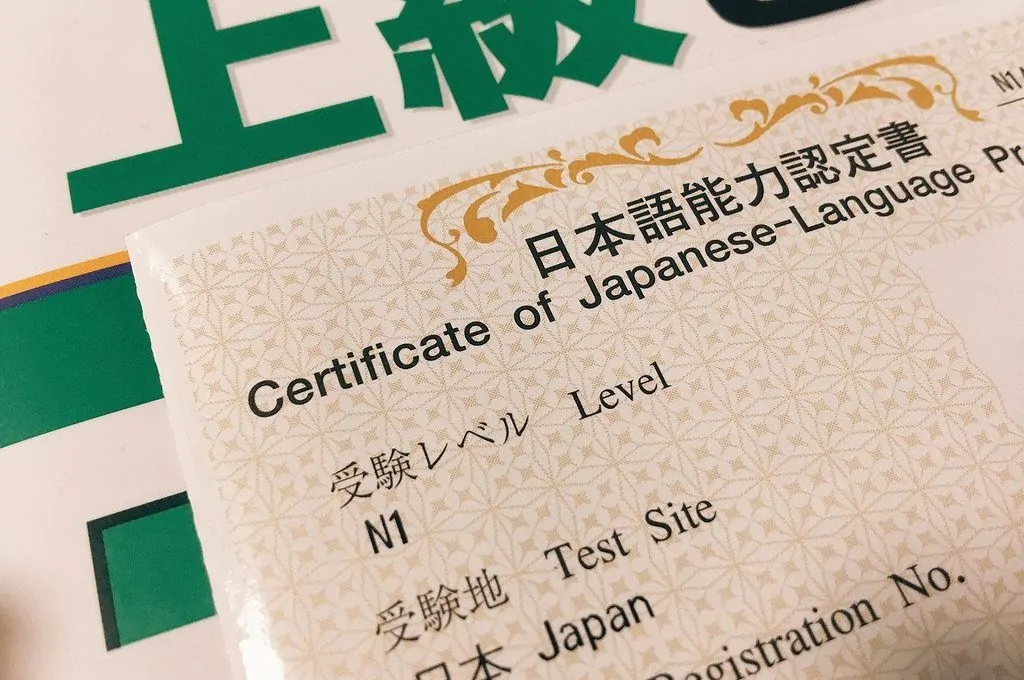If you are looking to study the Japanese language, you will likely come across the JLPT. The Japanese Language Proficiency Test is an exam to evaluate your ability to understand written and spoken Japanese. You can take this standardized Japanese language certification at various levels depending on your current Japanese language knowledge (N1, N2, N3, and so on).
In this article, we will cover everything there is to know about the JLPT: what it is, how to apply, when and where to take it, and how to be ready on D-day!
What Is The JLPT?
The JLPT is a standardized multiple-choice to examine and certify the proficiency of non-native speakers in the Japanese language. It was first held in 1984 by the Japan Foundation and Japan Educational Exchanges and Services with assistance from representatives at major Japanese universities.
Although it started as a small-scale event, it has since expanded to more than 80 countries worldwide. It comprises five levels, N1 being the hardest and N5 the easiest.
It is a very advantageous certificate to own for multiple reasons. For example, the JLPT is often a requirement for foreigners who wish to study in Japan at a language school or university, and companies usually use JLPT scores as criteria for employment. Moreover, you will likely receive preferential treatment at the Immigration Bureau of Japan if you own a JLPT certificate.
What Are the Different JLPT Level and their Prerequisites?
Up until 2010, there were only 4 JLPT levels. Then the organizers introduced a new exam version, and today you have the choice between 5 different levels. Technically, applying for the test doesn’t require any prerequisite. However, you need to have an adequate Japanese level to succeed during your chosen exam.
Here is an overview of the linguistic competence required for the different JLPT test levels:
JLPT N5: The N5 is the most accessible level for people who know basic Japanese. To pass this test, you must be able to read hiragana and katakana, as well as the most basic kanji (around 100). You also need to comprehend short and slow exchanges concerning daily life (typical phrases you would learn in a classroom).
JLPT N4: This is an intermediary level for people who feel they are above the beginner N5 level yet not ready for the more advanced level N3. At this level, you need to know how to read and understand around 300 kanjis and about 1500 words in terms of vocabulary. You also must be capable of picking up important information from daily conversations spoken at a slow pace.
JLPT N3: The N3 is the mid-level accessible to people who can follow everyday conversations at a nearly normal speed. There is a real difficulty gap between N3 and the N4 and N5 levels. At this point, your Japanese language knowledge is at an intermediate level. You need to know around 700 kanjis and 4000 words and be familiar with essential grammar points. You should understand ordinary written Japanese such as newspaper headlines, and speak Japanese with reasonably simple vocabulary.
JLPT N2: Things start getting more challenging when you aim for the N2. This level is for advanced Japanese learners who have studied at least 1000 kanjis and memorized over 6000 words. They can read and understand various written materials such as short stories and articles in the newspapers and magazines. They can also comprehend oral materials (conversations, simple TV programs) at a natural speed and identify the essential points with ease; they also can have coherent conversations on any topic.
JLPT N1: N1 is the most complex and therefore challenging JLPT level. It requires its candidates to have a high level of both spoken and written Japanese. You will need to learn about 2000 kanjis and over 10 000 words. Of course, you must also be familiar with grammar points and expressions used in more demanding written materials such as newspapers and business documents. Concerning the listening part, you must be able to process the progression of ideas in a relatively complex speech at normal speed (long conversations, lectures, news reports).
For more details about the required competencies for each level, you can visit the following website: JF Japanese Language Proficiency Test.
When and Where to Take The JLPT?
It is offered in Japan and locations worldwide on specific dates twice a year. The first test is in July, while the second one is in December. Although the test date will always be within those two months, the test dates may change from one year to another. Also, the July test is not happening in every city.
In addition, note that there may be some cities outside of Japan where the test is offered only once a year, either in July or December.
The Japanese Language Proficiency Test in Japan is offered in about 60 locations, including major cities such as Tokyo, Osaka, and Nagoya. JLPT tests are also available in many other countries, including the U.S, Canada, Australia, New Zealand, the U.K, France, and Singapore. To offer so many possible host institutions around the world, the organizers cooperate with the main universities of each country where the exam is available.
If you think of registering, check the list of overseas test site cities and verify which examination site is the closest to you and when the next JLPT will occur.
How Much Does It Cost?
The JLPT is not an overly expensive exam and is worth your money if you want a reliable certificate to prove your skills in the Japanese language. The price varies from country to country and may also differ depending on the difficulty level.
Here are some references to give you an idea:
- Japan: ¥6500
- USA: $100
- Canada: $70 CAD
- UK: £85
- France: €75 (N3, N4, N5) or €85 (N1, N2)
Depending on the location of your chosen examination site, test takers may also need to pay for transportation and accommodation for the day.
How does The Exam work?
The Japanese Language Proficiency Test is a paper-based multiple-choice test with usually four choices and one correct answer. While the exams for N1 and N2 are divided into two sections (Vocabulary/Grammar/Reading – Listening), N3 to N5 have three sections (Vocabulary – Grammar/Reading – Listening).
The harder the level, the longer the test:
- N1: Vocabulary/Grammar/Reading 110 min – Listening 60 min
- N2: Vocabulary/Grammar/Reading 105 min – Listening 50 min
- N3: Vocabulary 30 min – Grammar/Reading 70 min – Listening 40 min
- N4: Vocabulary 30 min – Grammar/Reading 60 min – Listening 35 min
- N5: Vocabulary 25 min – Grammar/Reading 50 min – Listening 30 min
On top of vocabulary, grammar exercises, and reading, the test also has a kanji portion (Chinese characters). For the listening section, you will be given an audio recording of people speaking in Japanese and will then need to answer questions related to what you heard. Know that all the written or oral questions will be given in Japanese only.
How To Pass the JLPT Test?
There are two conditions to pass the JLPT. Firstly, your total score must be equal to or above what is called the ¨overall passing score¨, which is different for each level. To be specific, you will need a total score of:
- N1: 100/180
- N2: 90/180
- N3: 95/180
- N4: 90/180
- N5: 80/180
Secondly, you need to have a score equal to or above the ¨passing score¨ for each test section, which is 19/60 per section. Let’s imagine; for example, you managed to score a total of 85 points for the N5. However, you did poorly in the listening section and only got 15/60. In this case, you have failed your test because one of your sectional marks was under 19/60 (regardless of your total score being above the overall passing mark).
Once you take the test, the official results will be announced online in late January for the July session and late August for the December session.
Things To Know Before Taking the Exam
You must bring an HB-graded or mechanical pencil to write your answers. Any other types of writing utensils will be refused. Having an eraser with you is also recommended to correct your potential mistakes.
By the way, a common mistake made by the candidates is to shift their answers while filling in the answer sheet. When filling the right circle with a dark mark, be extra careful not to fill in the wrong line. In addition, try to fully darken the circle so the machine won’t have difficulty processing the results.
Finally, remember to bring a valid ID with a photo for identity verification purposes, or you won’t be allowed to take the test.
How To Apply Online for the JLPT Inside and Outside of Japan?
All non-native speakers of Japanese are eligible for application, even if they have Japanese nationality. Once you decide to apply, the first thing to do is find out when and where you can take the test in your country.
How To Apply for the JLPT in Japan?
To apply online, go to the official JEES website and create a ¨MyJLPT¨ account. The application period starts around late March for the July session and late August for the December session. Once you register your personal information and pay the application fee, you will receive a test voucher to bring with you on D-day.
Japan has 11 different test areas, each regrouping one or more prefectures. A test site within your local test area will be assigned to you during your registration. However, note that it might be in a different prefecture than where you live.
How To Apply Outside of Japan?
First of all, check out the list of overseas test site cities. It will lead you to the organization in charge of the Japanese Language Proficiency Test in your country and their official website. The JLPT in the USA, for example, is managed by the American Association of Teachers of Japanese.
The USA only offers one test in December, and registration opens in August. Just follow the steps mentioned on the website and submit your application and payment. You will, later on, receive an official letter along with a test voucher. Keep in mind you will need it on the fateful day.
Here is a list of the universities which hosted the Japanese Language Proficiency Test in 2021: Georgia State University, DePaul University Lincoln Park (N1, N2, N3 only), University of Arkansas, University of Hawaii (N1, N2 only), Japan Foundation L.A (N1, N2 only), Florida International University, Villanova University, and Georgetown University. Though only a few sites were available because of COVID 19, there are usually more (18 in total in 2019).
How To Get Prepared for The JLPT?
You first need to find out which test you should take. An excellent way to evaluate your Japanese skills is to try answering JLPT sample questions of different levels, starting with the easiest. You will find here standard questions from N1 to N5. Once you have identified which test to take, the next step is to start preparing! The obvious course of action would be to take intensive Japanese classes. Nevertheless, other great resources to help you prepare are less expensive, if not free!
Online Resources and Mobile Apps
You can find many helpful sites online covering vocabulary, kanjis, grammar points, and listening exercises sorted by JLPT levels. Here are a few examples:
- Japanese test 4 you
- Jlpt Sensei
- Kanji123
Another way to study your Japanese is through mobile apps. Most of them are free and allow you to take mock tests wherever and whenever you want via your smartphone or tablet. You will find below some of the best apps you can download right away:
- JLPT Test N5 N4 N3 N2 N1
- Migii
- Obenkyo (Android only)
Japanese Textbooks
A book is a way to go if you want a more traditional learning approach. We recommend you get your hands on the JLPT Official Practice Workbook published by the Japan Foundation. They cover general knowledge for each JLPT level, costing about $7 in Japan.
If you want to study specific points more than others, you can purchase books only focusing on vocabulary, grammar, kanjis, reading comprehension, or listening. In this case, the 5 New Kanzen Master collection is your best option.
They include a comprehensive review of each section covered by the JLPT, as well as clever tips and exam simulations. One book on Amazon will cost you between 18 to 25 dollars.
To Conclude
In this article, we explored the JLPT exam and what it entails. We also provided you with information on how to apply and be prepared if you are considering taking it in the future. And really, you would be right to give it a try because this certificate is advantageous for your carrier and never expires! Once you pass it, you have it for life. The only thing left to do now is register for your country’s JLPT exams and start reviewing.
Frequently Asked Questions about Japanese Language Proficiency Test:
The price of the JLPT test may vary depending on the location of the examination. In the US, it would cost you $100, while in Japan, the price would be just about $50.
The Japanese Language Proficiency Test is designed to evaluate the linguistic competence of Japanese language learners. So the JLPT certifies that you can understand Japanese and speak Japanese to a certain degree depending on your passing level.
It depends on the JLPT test level you pick and also on your knowledge of Japanese.
If you want to find a job in Japan, JLPT is usually necessary to get a proper job. Usually, the N2 level is required, sometimes just N3 for some tech positions. Foreigners entering Japanese universities often need to pass JLPT to get accepted.
You don’t need to head to Tokyo to pass the test as there are plenty of locations anywhere in the world; please refer to the JLPT official site for test location information and online registration.





Leave a Comment